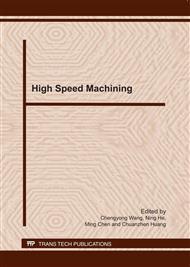[1]
Weinert K, Inasaki I, Sutherland J W, et al. Dry Machining and Minimum Quantity Lubrication [J]. Annals CIRP, 2004, 53(2): 511-537.
DOI: 10.1016/s0007-8506(07)60027-4
Google Scholar
[2]
Toshiyuki Obikawa, Yasuhiro Kamata, Yuki Asano, et al. Micro-liter lubrication machining of Inconel 718 [J]. International Journal of Machine Tools & Manufacture, 2008, 48: 1605-1612.
DOI: 10.1016/j.ijmachtools.2008.07.011
Google Scholar
[3]
Kamata Y, Obikawa T. High speed MQL finish-turning of Inconel 718 with different coated tools [J]. Journal of Materials Technology, 2007, 192-193: 281-286.
DOI: 10.1016/j.jmatprotec.2007.04.052
Google Scholar
[4]
Toshiyuki Obikawa, Yasuhiro Kamata, Jun Shinozuka. High-speed grooving with applying MQL [J]. International Journal of Machine Tools & Manufacture, 2006, 46: 1854-1861.
DOI: 10.1016/j.ijmachtools.2005.11.007
Google Scholar
[5]
Toshiyuki Obikawa, Yuki Asano, Yasuhiro Kamata. Computer fluid dynamics analysis for efficient spraying of oil mist in finish-turning of Inconel 718 [J]. International Journal of Machine Tools & Manufacture, 2009, 46: 971-978.
DOI: 10.1016/j.ijmachtools.2009.06.002
Google Scholar
[6]
MA Lijie, WANG Guicheng, ZHANG Chunyan. Application of Minimum Quantity Lubricant in Vibration Drilling[J]. Journal of Mechanical Engineering, 2009, 45(1): 223-234.
DOI: 10.3901/jme.2009.01.223
Google Scholar
[7]
J AWilliams, D Tabor. Role of lubricants in machining [J]. Wear, 1977 (3): 275 - 292.
Google Scholar
[8]
J A Williams. The Action of Lubricants in Metal Cutting [J]. Journal Mechanical Engineering, 1977 (5): 202 - 212.
Google Scholar
[9]
V A Godlevski, A V Volkov. The Kinetics of Lubricant Penetration Action during Machining [J]. Lubrication Science, 1997 (9) : 127 - 140.
DOI: 10.1002/ls.3010090203
Google Scholar
[10]
V A Godlevski, A V Volkov. A Description of the Lubricating Action of the Tribo-Active Components of Cutting Fluids [J]. Lubrication Science, 1998 (11): 51 - 62.
DOI: 10.1002/ls.3010110106
Google Scholar
[11]
Han Rongdi, Liu Junyan. The Kinetic Modeling of Cutting Fluid Penetrated Capillary During Machining [J]. LUBRICATION ENGINEERING, 2005(167): 31-36.
Google Scholar
[12]
Zheng Wenjie, Pei Hongjie, Wang Guicheng. Study on Less Fluid Cutting Mechanism [J]. Tool Engineering, 2008, 42(10): 64~67.
Google Scholar
[13]
Guo Yonghuai. The boundary layer theory [M]. Hefei: University of science and technology of China press, (2008).
Google Scholar
[14]
Wu Minjing. Status and Trends of MQL Machining [J]. AVIATION PRECESION MANUFACTURING TECHNOLOGY. 2004, 40(1): 24-26.
Google Scholar


